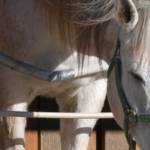Sick Horses: Feed Them Less or More?

If a horse stays at an ideal body weight and has plenty of energy for the exercise program it is on, the owner can usually assume that the horse’s feeding program is adequate. However, feed management is not so simple when horses are sick, injured, or recovering from illness.
Usually, moving a pastured horse into 24-hour stalling will decrease its energy needs because free exercise has been curtailed. Also, athletic horses that have sustained minor injuries, are recovering from elective orthopedic surgery, or have mild bacterial or viral infections should have a reduction in energy intake. During convalescence and until resumption of training, most of these horses can be maintained on a diet composed primarily of hay fed at 1.5 to 2.0% of body weight per day, a vitamin/mineral supplement, and salt, either loose or in a block. To facilitate the return to full grain feeding upon return to training, it may be desirable to continue feeding a small amount of grain each day.
In contrast, metabolic rate can rise significantly for some stalled equines. Confined horses that are healing from a severe injury may need more than a one-third increase in dietary energy, and those that have endured serious infections or major burns might require up to 1.7 times the normal amount as they recover. These horses will also need more protein as they rebuild damaged tissues.
Another situation exists with sick foals. Premature foals and those that have been diagnosed with neonatal maladjustment syndrome (NMS) may have metabolic rates that are only about 50% compared to healthy, age-matched counterparts. This may be due to the sick foals lying down most of the time, while healthy foals are active during most of the hours they are awake. Despite their low rates of metabolism, these foals can be in negative energy balance because of very low milk intake.
Feeding levels should be based on the horse’s body weight, previous exercise program, and current state of health. For horses that can’t or won’t eat willingly, it is often difficult to meet maintenance requirements. Nonetheless, delivery of even part of the maintenance requirement is likely to be beneficial in sick horses. The primary goal is to prevent further loss of body weight.
If a sick horse is willing and able to eat, this should be encouraged, even if the animal doesn’t consume the amount usually eaten. If the horse consumes at least 85% of its optimal intake, no other form of nutritional support is required unless the illness is prolonged and the horse begins to lose an unacceptable amount of weight.
Pain and fever can depress appetite, and suitable medications can improve the horse’s comfort in many cases. Although hospitalized horses should be offered feeds similar to those fed at home, it is often necessary to provide a variety of feedstuffs to encourage intake. Highly palatable feeds such as fresh grass, leafy hays, and small amounts of grain or bran mash containing some grain can be offered. For horses that have not been eating, only small amounts of these feeds should be offered initially to avoid problems such as diarrhea and laminitis. Increases in grains or concentrates should be limited to less than one pound (0.5 kg) per day for an average-sized mature horse. Various types of forage and feed can best be provided in small, frequent meals throughout the day.
Veterinarians and equine nutritionists can advise owners on the best way to prevent excessive weight loss and support recovery in sick or injured horses that are being cared for at home.








